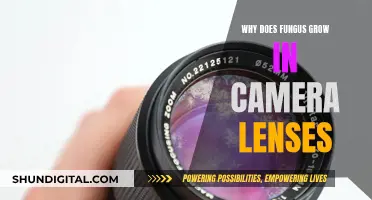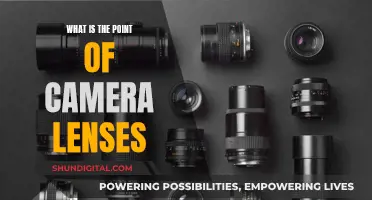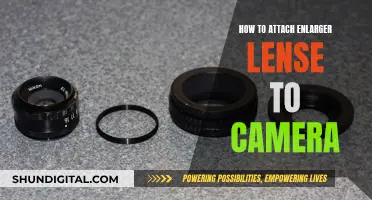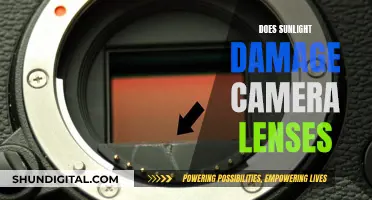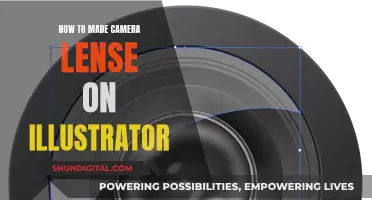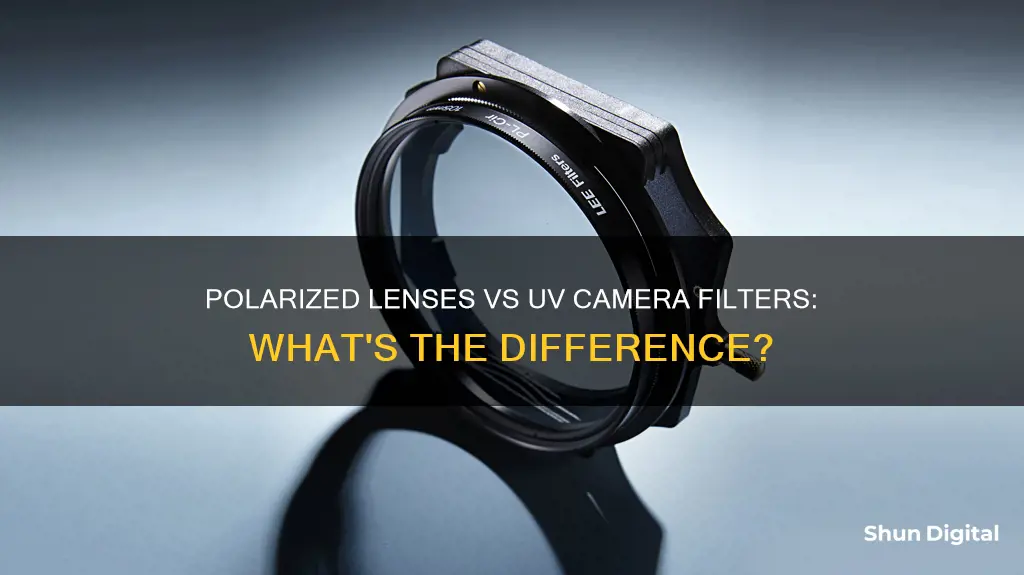
Polarized and UV lenses may look similar, but they are used for very different purposes. A UV filter, also known as a UV haze filter, absorbs ultraviolet light waves that the human eye cannot see. UV light often makes outdoor scenes appear hazy or foggy in photos. By filtering out UV rays, these filters produce more accurate colour renditions. A polarizing filter, on the other hand, eliminates glare and enhances saturation by blocking light that oscillates on a horizontal plane while allowing vertical light to pass through. This has the effect of darkening blue skies, minimizing reflections, and boosting colour saturation.
| Characteristics | Values | |
|---|---|---|
| Purpose | Protection, reducing UV light | Reducing glare, enhancing saturation |
| Effect on image | Minimal effect on image quality | Noticeable changes to image |
| Use case | Always on for protection | Selective use for specific scenes |
| Cost | $10-$50 | $75-$200+ |
What You'll Learn

The purpose of UV filters
UV filters are primarily used to reduce the amount of ultraviolet light that enters a camera lens. They are attached to the front of the lens and act as a form of "sunscreen" for the camera, blocking UV rays from passing through. This is particularly important for film photography, as film stock is more sensitive to UV light, which can cause discolouration and a blue haze in photos.
With the advent of digital photography, UV light became less of an issue as digital cameras are not as sensitive to UV light. However, photographers who shoot digitally still find UV filters useful as a form of protection for their lenses. UV filters can safeguard lenses against scratches, dust, liquids and other environmental hazards.
When to use a UV filter
While UV filters can provide protection, they may also cause a slight reduction in image quality. They can decrease the amount of light entering the camera, which can affect image sharpness and contrast. Therefore, it is recommended to use UV filters in situations where lens protection is a priority, such as in outdoor photography or when shooting in environments with potential hazards like dust, water or sand.
For studio photography or other controlled settings where image quality is a higher priority, it is generally advised to remove the UV filter to avoid any potential impact on image sharpness.
It is worth noting that the effectiveness of UV filters depends on their quality. High-quality UV filters from reputable brands are less likely to cause issues with image quality, while lower-quality filters may introduce lens flare, reduce contrast or affect colour accuracy.
Interchangeable Lens Cameras: Are They Worth the Hype?
You may want to see also

The purpose of polarizing filters
Polarizing filters are an essential tool in a photographer's kit, often being the first filter that landscape photographers buy to enhance their images. They are typically placed in front of a camera lens to reduce reflections, haze, and increase colour saturation. They are also one of the only lens filters that cannot be replicated using digital photo editing.
Polarizing filters work by blocking light that oscillates on a horizontal plane while allowing vertical light to pass through. The sun produces intense horizontal light waves, so a polarizer can have dramatic effects, especially for outdoor photography.
There are two types of polarizing filters: linear and circular. Linear polarizers are cheaper but can interfere with autofocus on modern DSLR lenses. Circular polarizers are compatible with any camera but are more expensive.
The benefits of using a polarizing filter include:
- Darkening blue skies
- Minimizing reflections
- Boosting colour saturation
- Cutting through haze
When to Use a Polarizing Filter
Polarizing filters are most effective when used at a 90-degree angle from the sun. This means you shouldn't use a polarizer facing directly towards the sun. The effect of the filter also depends on the time of day and year, as the position of the sun impacts the amount of polarization obtained from the filter.
One of the main reasons photographers use polarizing filters is to reduce reflections in a scene. This is particularly useful when shooting through glass or other polished surfaces such as water. Polarizing filters can also be used to reduce haze, which is often an issue in landscape photography.
While polarizing filters have many benefits, there are some disadvantages to consider:
- They can make the sky appear unnaturally dark or uneven, especially when using a wide-angle lens.
- They require more time to set up and use, as they need to be rotated to adjust the level of polarization.
- They reduce the amount of light entering the lens, which can lead to underexposure.
- High-quality polarizing filters can be expensive.
- They can add more ghosting and flare to images, especially if the filter is not kept clean.
- They can add vignetting when used with some wide-angle lenses.
Overall, polarizing filters are a valuable tool for photographers, especially those shooting landscapes, cityscapes, and architecture. They can help to enhance images by reducing reflections and haze and boosting colour saturation and contrast. However, they should be used sparingly and with careful consideration of the lighting conditions and desired effect.
Camera Lenses: Waterproof or Not?
You may want to see also

The effects of UV filters on photographs
Ultraviolet (UV) filters are designed to absorb UV light, which is invisible to the human eye but can cause haze in photographs. They are also used to protect lenses from dust, dirt, scratches, and other potential damage. While some sources claim that low-quality UV filters can decrease image sharpness, high-quality UV filters should not affect image quality.
- Haze reduction: UV filters can reduce atmospheric haze, resulting in clearer and more vibrant images, especially in outdoor and challenging environments.
- Image quality enhancement: In certain conditions, UV filters can minimize the blue colour cast caused by UV light and enhance colour saturation.
- Lens protection: UV filters act as a protective layer, safeguarding expensive lenses from accidental damage and general wear and tear.
It is important to note that the necessity of UV filters is a topic of debate in the photography community. With advancements in digital cameras, some argue that built-in sensors eliminate the need for UV filters. Additionally, there are potential downsides to using UV filters, such as inducing unwanted flares and affecting the performance of optically superior lenses. Ultimately, the decision to use a UV filter depends on individual shooting conditions, personal preferences, and the value of the camera equipment.
How Camera Lenses Use Refraction to Capture Images
You may want to see also

The effects of polarizing filters on photographs
Polarizing filters are placed in front of a camera lens to darken skies, manage reflections, and suppress glare from bodies of water or the road. They are particularly useful for outdoor photography because of the way they can counteract the natural glare of sunlight. They can also be used to enhance the colour of water at the beach, rescue highlights from bright snow or ice, and improve contrast in the middle of the day when the sun is at its harshest.
Polarizing filters can increase colour saturation and decrease reflections. They work by blocking light that oscillates on a horizontal plane while allowing vertical light to pass through. This has the effect of reducing reflections and enhancing saturation.
When using a polarizing filter, it's important to note that they can make the exposure require 2-3 stops (4-8x) more light than normal. They also require the camera to be pointed at a right angle to the sun for maximum effect. They can also be difficult to visualize when using the camera's viewfinder and take longer to compose as they need to be rotated.
When buying a polarizing filter, you need to get the size that matches the thread diameter of your lens. If your lens has a 77mm diameter, you'll want a 77mm polarizer. There are two classes of polarizing lenses: circular and linear. If you're using a DSLR with autofocus, you'll want a circular polarizer. Linear polarizers are cheaper but can interfere with autofocus on modern DSLR lenses.
Camera Lenses: Is Price Tag Directly Linked to Quality?
You may want to see also

When to use UV vs. polarizing filters
UV and polarizing filters are two of the most common accessories used by photographers. Although they may look similar, they serve very different purposes.
UV filters
UV filters, also known as UV haze filters, absorb ultraviolet light waves that the human eye cannot see. UV light often makes outdoor scenes appear hazy or foggy in photos. By filtering out UV rays, UV filters produce more accurate colour rendition. They are also designed to be left on lenses at all times for protection against dust, moisture, scratches, and accidental bumps.
Polarizing filters
Polarizing filters eliminate glare and enhance colour saturation. They work by blocking light that oscillates on a horizontal plane while allowing vertical light to pass through. This has a dramatic effect on outdoor photography, especially when shooting water or reflective surfaces.
When to use UV filters
- Landscape photography: UV filters improve clarity by reducing haze.
- Beach photography: Filters protect against sand damage and improve clarity by reducing haze.
- High-altitude photography: UV filters are beneficial at higher elevations where there is greater UV intensity.
- Permanent lens protection: UV filters protect lenses from dust, dirt, rain, etc.
When to use polarizing filters
- Cutting water reflections: Polarizing filters bring out detail below the surface of oceans, lakes, and rivers.
- Boosting skies and foliage: Polarizing filters enhance colour and contrast in landscape photography.
- Reducing glass glare: Polarizing filters cut unwanted glare and reflections when shooting through glass or other reflective surfaces.
- Outdoor portrait photography: Polarizing filters reduce facial shine and enhance colours in outdoor backgrounds.
Using UV and polarizing filters together
It is possible to use UV and polarizing filters together. Simply attach the UV filter to the lens first, then add the polarizing filter on top. However, this might not always be beneficial as stacking filters can lead to image degradation, increased chances of lens flare, and vignetting (corner darkness).
DX Lenses: Compatible with FX Cameras?
You may want to see also
Frequently asked questions
UV filters are primarily used to reduce the amount of ultraviolet light entering the camera, which can negatively affect photographs taken at high elevations and cause hazing or a blue fringe around the photo. They also act as a barrier to protect the lens from scratches and cracks. Polarizing filters, on the other hand, absorb UV light and reduce glare from shiny surfaces like water or glass. They enhance images by making clouds pop against the sky, reducing haze, and increasing colour saturation and contrast.
UV filters are not necessary for digital cameras as the camera sensor already has a UV filter built-in. However, they can still be useful for film cameras and when shooting at high altitudes. Additionally, UV filters can serve as protection for your lens against scratches and cracks.
Polarizing filters are not necessary for all types of photography but are particularly useful for landscape and architecture photographers. They can enhance images by reducing haze, boosting colour saturation and contrast, and reducing reflections.
Yes, you can stack a UV filter and a polarizing filter together. The general recommendation is to attach the UV filter directly to the lens for protection and then add the polarizing filter on top. However, keep in mind that stacking filters may lead to issues such as image degradation, lens flaring, and vignetting.


